RENEGADE GARDENER™
The lone voice of horticultural reason
The 2014 Renegade Gardener High Spot / Black Spot Awards

1-7-15 – Havana, Cuba – Saludos mis buenos amigos de todo el mundo, en vivo desde el Paradisus Varadero Hotel y Spa, La Habanna, Cuba, es el Renegado Jardinero Punto Alto/Punto Negro Premios!
Not bad for a five-minute Spanish lesson from a Cuban street vendor, aided by a communal pint bottle of rum, eh? Another way to put it: Greetings my good friends from around the globe, live from the Paradisus Varadero Hotel and Spa, Havanna, Cuba, it’s the Renegade Gardener High Spot/Black Spot Awards!
My apologies for the delay in presenting tonight’s program, originally scheduled for January 1. The location was decided upon the minute I heard the news of the softening in relations between the U.S. and Cuba, this mysterious, forbidden jewel of the Caribbean.
My first call was to a good friend high up in the U.S. Department of Agriculture – the Renegade Gardener has nothing if not connections – who rubber stamped a travel visa for my crew and I on the pretense of setting up a meeting between high-ranking U.S. Department of Agriculture experts (us, I guess) and our counterparts in the Cuban Government, to discuss agricultural trade.

Once we made it through customs at the Havana airport, or course, we blew off the meeting, and headed immediately to the beaches and bars. Not to worry – the Cuban Officials blew off the meeting as well. How did we find out? We ran into them at the bar. At midnight, we all went skinny fishing.
The hotel is fantastic – good job Mitch P. at the Department of Ag – but we did lose about a week trying to find and rent film and sound equipment, stage, chairs, pencils, and all other necessary items, plus this year’s panel of judges kept disappearing and phoning my room at four in the morning to ask me where they were. You’re in Cuba, I would tell them. “Bueno!” they would shout into the phone, while the crowd of people I could hear in the background would break into laughter and song.
In the daytime, things move a bit slowly down here in Cuba. Aside from chatter about the High Spot/Black Spot Awards being held here, the biggest buzz on Havana streets is about next month’s unveiling of the 1960 Chevy Pickup.
But enough with the excuses – let’s give out some awards!
High Spot Award
Best Gardening Trend: Floral Additions to Male Beards

Regular attendees to this annual awards ceremony know that nothing presented here is made up (I really am in Cuba), so sit back and applaud the facially hirsute young men of England (where else?) who have started decorating their beards with cut flowers.
A hip new trend to welcome summer in London, I doubt it will be long before it migrates to the US, where it no doubt will join “Who invented punk rock?” as a topic of debate between the two countries. Americans are sure to point out that travelers to San Francisco in the ‘60s were instructed to wear a flower in their hair.

Photos are used with permission of England’s The Telegraph newspaper, easily the best newspaper on the planet. And by the way, The New York Dolls, followed by New York musician Richard Hell, invented punk rock.
High Spot Award
Best Gardening Book: What a Plant Knows
By Daniel Chamovitz (Farrar, Straus and Giroux/2012)
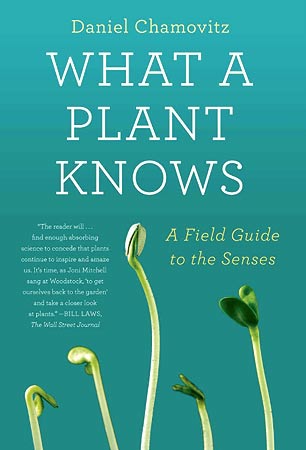
Unlike the Russian missiles that arrived in Cuba in 1961, this amazing book spent a few years under the radar. It’s so good, however, that the judges found nothing incongruous with awarding the 2014 Best Gardening Book prize to a volume published in 2012.
One needn’t be a gardener to be fascinated by What a Plant Knows. Renowned biologist Chamovitz’s research, theories and opinions on how plants think, see, feel, smell and communicate make this one of the great non-fiction page-turners you’ll read this year, no small feat for a science book.
How do plants know up from down? How do they transmit warnings to nearby plants when attacked by a pest, or weakened by drought? How can they tell when a neighboring plant is sick? How is that a tree knows the color of your shirt? How can they possibly maintain memories? Or recognize the difference between Led Zeppelin and Bach?
Key to the enjoyment factor is Chamovitz’s lively, non-technical writing style. Sometimes humorous, sometimes passionate, yet always thought provoking, What A Plant Knows should be placed atop your winter reading list.
More Info: www.whataplantknows.com
Black Spot Award
Worst Government Overreach: Vermont’s 6% Greenhouse Use Tax
Facing a $72 million deficit in 2015, Vermont’s state government is doing what governments do best when expenses exceed revenues: raising taxes on businesses. So with abnormally cold spring and summer weather over the past two years aiding in the decline in state nursery sales, what defenseless industry has Vermont politicians chosen to pillage? The state’s nursery industry.
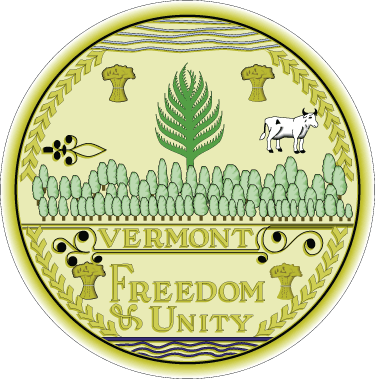 State auditors have begun removing wholesale agricultural sales and tax exemptions and auditing wholesale nurseries. One such nursery, Green Mountain Wholesale Florist, was told by auditors that the business is now classified as retail, not wholesale, and that they owe more than $200,000 in back taxes, since the new rules are retroactive three years, to 2011. Owner Tom Jennings states that he is so knowledgeable about requirements of use and tax ID numbers that he regularly reports over 20 customers to state tax authorities that he thinks should not be taking tax exempt status. His reward? An overall tax increase of six percent on raw materials – pots, boxes, greenhouse film, foam, plant tags, and other components.
State auditors have begun removing wholesale agricultural sales and tax exemptions and auditing wholesale nurseries. One such nursery, Green Mountain Wholesale Florist, was told by auditors that the business is now classified as retail, not wholesale, and that they owe more than $200,000 in back taxes, since the new rules are retroactive three years, to 2011. Owner Tom Jennings states that he is so knowledgeable about requirements of use and tax ID numbers that he regularly reports over 20 customers to state tax authorities that he thinks should not be taking tax exempt status. His reward? An overall tax increase of six percent on raw materials – pots, boxes, greenhouse film, foam, plant tags, and other components.
If you’ve never owned a business that sells products to another business that ultimately sells a finished product at the retail level, the retailer is responsible for charging a final sales tax, and paying it to the government. What you have in Vermont is a double tax, a classic government manipulation of markets that inevitably leads to price increases to the consumer.
“They’re on a witch hunt,” says Chris Conant of Claussen’s Greenhouse in Colchester. Chris and other nursery owners are fighting back, and good Renegade Gardeners in the Green Mountain State are encouraged to contact either Chris or Tom, followed by calls and e-mails to their state legislators.
High Spot Award
Perennial of the Year: Schizachyrium Blue Heaven™
(Little Blue Stem)
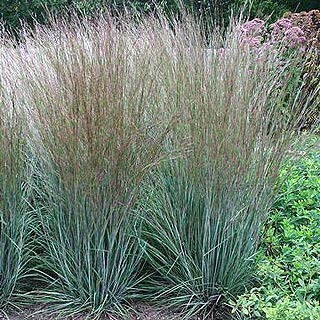
Dr. Mary Meyers at the University of Minnesota leaves a lasting mark on international landscape design through her work developing this variety of Little Blue Stem grass. In just seven years on the market, ‘Blue Heaven’ can be found in nurseries and gardens across North America and Europe.
Loving full sun but tolerant of less (four hours of midday sun will suffice), this grass maintains an upright habit featuring silvery blue foliage in the three- to four-foot range. It’s the fall change to dazzling red-purple-pink that seals the deal, and makes it such a desirable addition to gardens and landscapes of any size.
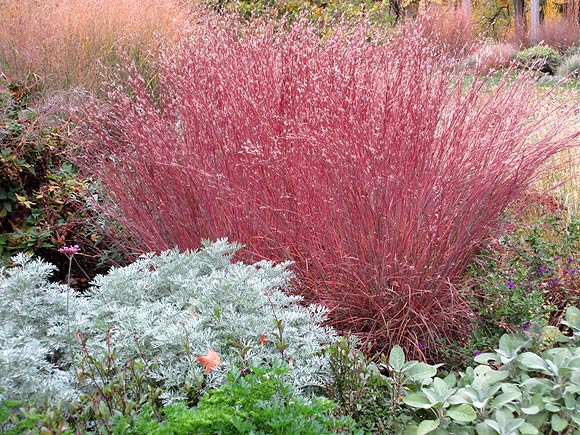
Tolerant of a wide range of soil types and pHs, ‘Blue Heaven’ thrives in USDA Zones 3-8.
Black Spot Award
Worst Plant of the Year: Rhododendron stenopetalum ‘Linearifolium’

This catastrophic Spider Azalea has recently snuck onto the grounds of a few American nurseries like a marauding Theraphosa blondi (South American Goliath Birdeater spider) hidden in the crates of a pottery shipment from Brazil. Run, in terror.
 Ugly to the point of instilling fear, this Japanese native…thing, is of course being touted by some nurseries as a must-have for any astute gardener. “So different that many people would not even suspect it is an azalea” states the website of one. Well, yeah, plus it’s so “different” many people would not even suspect it would be sold as a viable landscape plant.
Ugly to the point of instilling fear, this Japanese native…thing, is of course being touted by some nurseries as a must-have for any astute gardener. “So different that many people would not even suspect it is an azalea” states the website of one. Well, yeah, plus it’s so “different” many people would not even suspect it would be sold as a viable landscape plant.
Featuring long, narrow, drooping, dullish-pink flower petals spewing helter-skelter across mottled green foliage resembling unfertilized green beans in severe drought, this beat-up bush will spread to somewhere around four to six feet high and wide. “Some may say this is a plant only a true collector could love,” reads another website. Fair enough, though I would add it’s also a plant only a severely vision-impaired gardener would devote space to in his or her garden.
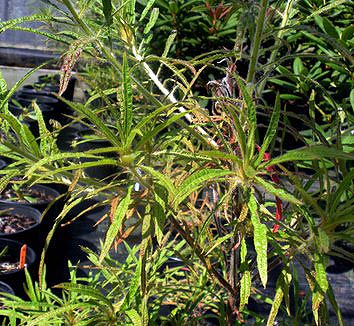
Hardy only to USDA Zones 7-9, thank God.
H igh Spot Award
igh Spot Award
Largest Tomato: Minnesota Gardener Smashes World Record
Nana-nana poo-poo, a zone 4 gardener from Ely, Minnesota, set the new world record in 2014 for the largest tomato ever grown, smashing a record that had stood for 28 years.
Dan MacCoy harvested the heavily lobed “Big Zac” variety in September, where it was weighed on a calibrated deli scale at Ely’s Northland Market, witnessed by a representative of the Great Pumpkin Commonwealth, the nonprofit that oversees the hobby of world-record fruit growing. Size is determined by weight, and Dan’s baby tipped the scale at 8.41 pounds.
It is expected that the Guinness World Records folks will also give MacCoy the nod.
Black Spot Award
Worst Behavior: Chinese Horticulture Experts Arrested in Attempted Seed Thefts
FBI agents arrested multiple Chinese nationalists in Iowa, Kansas and Florida and charged them with conspiring to steal advanced seeds from U.S. research farms and transport them to China.
Arrested in Kansas were Weiqiang Zhang, 47, an employee of Colorado-based Ventria Bioscience, and Wengui Yan, 63, a rice geneticist for the U.S. Department of Agriculture. One was chased from a seed test farm in Iowa, only to turn up later attempting to enter a different seed test farm. Later the FBI observed meetings between the two geneticists and several visitors from China, who were later found to be carrying seeds in their luggage on the return trip to China.
A third person detained, Mo Hailong, 44, is a Chinese citizen living in Florida who also was observed entering a DuPont test field in Iowa.
The FBI and State Department are treating the attempted thefts as a bit more than misdemeanors; a representative of Pioneer Seed, one of the U.S. growers, estimated that the loss of a line of specialty seed would lead to up to eight years’ lost research and total financial losses of $40 million.
Interesting to note that China’s State Council instituted a number of bans on genetically modified organisms (GMOs) in 2001. After research and testing, bans were lifted in 2013. Perhaps the Chinese have some catching up to do?
High Spot Award
Best News: School Gardens in Texas Credited With Raising Test Scores
 As reported in U.S. News and World Report, efforts by the nonprofit organization REAL School Gardens are paying amazing benefits. RSG created learning gardens in ninety low-income elementary schools across Texas, where teachers found them helpful not only for teaching science, but also math and language arts.
As reported in U.S. News and World Report, efforts by the nonprofit organization REAL School Gardens are paying amazing benefits. RSG created learning gardens in ninety low-income elementary schools across Texas, where teachers found them helpful not only for teaching science, but also math and language arts.
Several years into the program, schools with the gardens have seen a twelve to fifteen percent increase in their students’ standardized test pass rates. REAL School Gardens does more than just install the gardens; they provide training to teachers on how to incorporate gardening into their courses, and even provide lessons customized to the school’s needs.
Next up, RSG is expanding into the Washington, D.C. school district. If you’d like to learn more, check them out at www.realschoolgardens.org.
Black Spot Award
Worst News: Gardening Sales Continue Their Decline
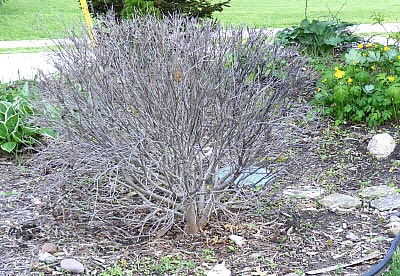
The recession of 2008, growth in less demanding hobbies, the continued aging of Baby Boomers and the short attention spans of Gen-Xers and Millennials are all part of the toxic mix that once again caused an overall decline in the size of the gardening industry through 2012.
The 2012 Census of Agriculture was released in 2014 by the U.S. Department of Agriculture, and while some news is good – total agriculture in America increased from $297.2 billion in 2007 to $394.6 billion in 2012 – the same cannot be said for expenditures on gardening.
The census is conducted twice every ten years, offering examination of trends over five years. Sales in Horticultural Specialties, meaning every plant type you can think of, were down in every category. The steepest declines were in cut flowers (19.8%) and potted houseplants (20.6%). And while annual bedding plants saw only a small decline of 2.9%, nursery crops overall – annuals, perennials, trees, shrubs – fell 22.3%, from $6.6 billion in 2007 to $5.1 billion in 2012.
I’m going to dovetail this study with one cited in an article in The Huffington Post that found the average American family has only 12 minutes to devote to breakfast. People are designing lives that leave them short on time, a key factor in skyrocketing divorce rates. Walmart is getting ready to open 300 mini-Walmarts called Neighborhood Express stores, and the fastest growing segment of supermarket retailing is convenience stores. If people are short on time to eat and shop for supplies, heaven help hobbies such as gardening.
So…with nursery reports pointing to equally dismal sales in 2013 and 2014, it’s a great age in which to be a garden writer, speaker, and alleged expert, not to mention a gardener. I realized a few years ago that it’s not the end of the world. It’s in a sense inevitable. Most Americans are four generations away from farmers, real landowners, small towns with village greens, wooded pathways to school, helping the parents harvest the vegetable patch, and summer jobs picking apples or mowing lawns. Most people under age 40 look at plants and horticulture as something you have an option to encounter, like deciding to spend one day a year at an art museum or zoo.
Attempting to expand the love of gardening in America is like the classical music industry launching PR campaigns and holding all-night meetings in an attempt to overtake country music, hip-hop and rock ‘n’ roll, to regain the premier status classical music enjoyed in the 1700s. It’s not going to happen. All we can do is garden to our hearts’ content. If you want to suggest a bit of gardening to the seething, frustrated adults you witness all around you, go ahead.
FYI, the best article I’ve written on the reasons behind gardening’s soft and subtle decline is named “Is Gardening Dead?” and can be accessed by clicking here.
High Spot Award
Deciduous Shrub of the Year: Sambucus racemosa ‘Lemony Lace™’
(Common Name: Elderberry)
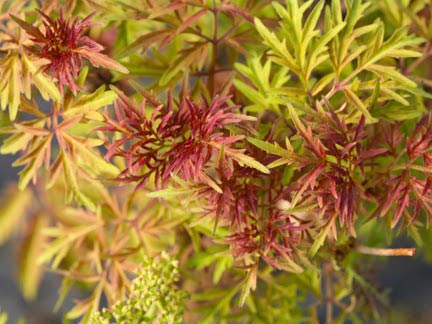 Rare it is for a plant to win this coveted award in the same year in which it makes it debut in garden centers, but this sterling new elderberry is such a delight the judges couldn’t resist. Plant form and foliage color are the two essential plant components in creating beautiful landscapes, and ‘Lemony Lace™’ scores high on both counts.
Rare it is for a plant to win this coveted award in the same year in which it makes it debut in garden centers, but this sterling new elderberry is such a delight the judges couldn’t resist. Plant form and foliage color are the two essential plant components in creating beautiful landscapes, and ‘Lemony Lace™’ scores high on both counts.
The deeply cut, lacy leaves emerge dark red then turn chartreuse with red edges in spring. Summer foliage color is gold-yellow. White flowers in mid-summer are small and not abundant, but who cares, it’s the showy foliage and sculptural look of the plant as a whole that appeals. Deep red berries appear in fall and while not edible to humans are highly sought after by birds. The plant is extremely unpalatable to deer.
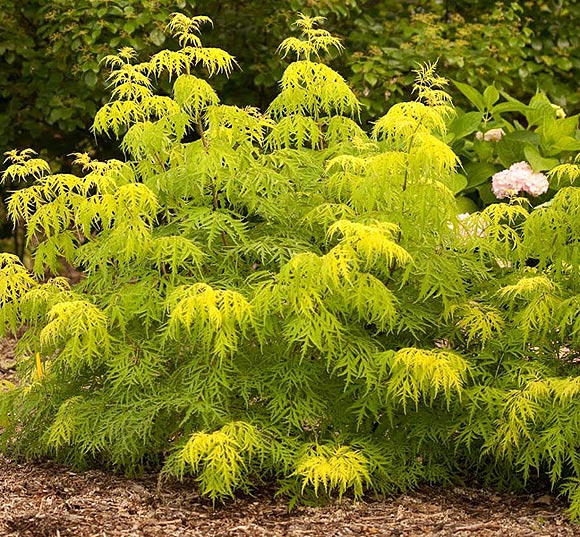
Growing three to five feet high by three to six feet wide, plants are ideal in the foundation border, as a backdrop in the perennial garden or anywhere you want a sleek blast of sunshine. Grow in decent soil that provides drainage. Plants require full sun in the north and part sun to shade south of the Mason-Dixon line. In zones 3 and 4, winter dieback can occur, but that’s a good thing; prune it just above emerging base buds in early spring and enjoy the gorgeous fresh foliage each season.
A Proven Winners™ introduction, ‘Lemony Lace’ grows in zones 3-7.
Black Spot Award
Most Disturbing Trend: Marketing GMOs as a Negative
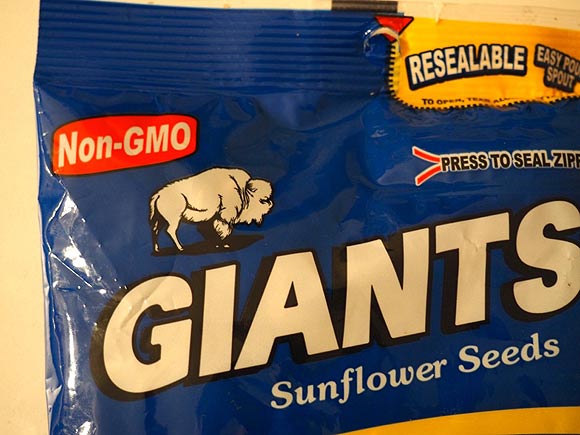
Stopped by a convenience store the other day (I was short on time) to pick up a fresh bag of sunflower seeds, and couldn’t help but roll my eyes. The manufacturer had joined a number of other food providers in advertising “Non-GMO” as if it’s a benefit. Which got me thinking…
Scientific ignorance on the part of the general public has long abetted marketers of products, who for decades have gauged public awareness on health issues and made profits based on erroneous perception – facts be damned.
Have you ever been fooled? Probably. Shampoo companies advertise their products’ unique combination of herbs, organic oils, and vitamins – there’s even a brand named “Vitamin Shampoo” – knowing that not one in fifty thousand consumers is aware that hair is not living tissue, has no circulatory system and cannot metabolize anything. Can a shampoo deliver vitamins or other nutrients into your hair? No. It’s not possible.
All shampoos have the same two components, a detergent for washing out dirt from the air and oil from the scalp, and a combination of chemicals that leave washed hair with a coating. This coating can make limp hair appear fuller (the chemical coating increases each hair’s diameter) and reduce the appearance of frizzy split ends (the chemical coating glues each hair back together) and it certainly can make your hair smell nice, but any improvement to the “health” of your hair is, well, purely cosmetic. Nothing penetrates hair.
Skin lotions and creams are another laugher. Nothing penetrates skin either, or rather, if it does, you’ve encountered a dangerous acid of some form. Yet consumers spend millions of dollars annually on expensive creams and lotions advertised to contain “moisturizing, healing, nourishing, regenerative” ingredients, such as oils from plants, vitamins, and helpful acids.
Apply them and your skin feels better, softer, but all that’s going on is the millions of dead skin cells on the surface are softened and/or removed. Age spots and other anomalies can be reduced via incorporation of mild topical acids. Some form of alcohol is nearly always present in the ingredients panel, since alcohol evaporates upon exposure to air, giving the user the impression that the lotion has been absorbed into the skin.
It’s utter nonsense. My father ran a cosmetics company for twenty years, hired and worked with the chemists it employed. He told me all the dirty little secrets above. He was a Norwegian, meaning it was difficult for him to confess them. He also had difficulty sleeping at night.
This bit of consumer education is provided on your behalf (granted, you learn more on this site by accident than by design) to make readers aware that when P.T. Barnum uttered the immortal words, “There’s a sucker born every minute,” he wasn’t referring to that person over there, he was referring to you and me. We’re all suckers about something, because we all have vast, hollow halls of ignorance inside our noggins.
And the anti-GMO crowd preys on this ignorance.
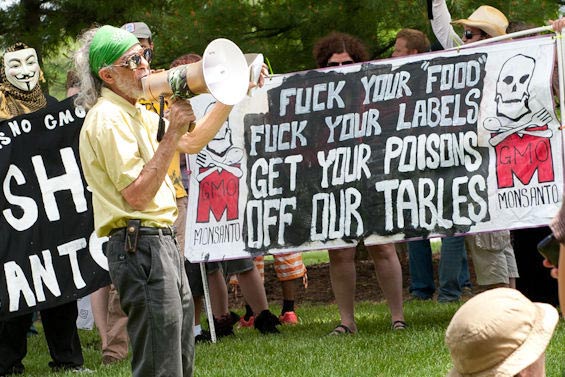
Since science is not even remotely on their side, anti-GMO activists rely on high levels of public ignorance to foist their ridiculous misinformation on the public in a coordinated and disciplined display of fear-mongering and populist alarmism. Saul Alinsky would be proud, but it’s at the expense of human lives, as we will see.
But first we need to quickly cover the wanton muddling of the terms “GMO” (genetically modified organism) and “GE” (genetic engineering) by the activists. The two terms are not interchangeable. GMO foods have their genetics altered in a variety of ways, from simple, controlled cross-pollination and grafting (which has been taking place in the world’s food supply for at least 2,000 years) to genetic engineering, which by definition means use of recombinant DNA procedures (DNA from one organism is inserted into that of another). All genetically engineered (GE) foodstuffs are genetically modified organisms (GMO), but not all genetically modified organisms are genetically engineered. In fact, most GMOs are not genetically engineered.
Ignorance of this key difference between the two terms allows opponents of genetic engineering to paint with a broad brush. It’s actually genetic engineering that has them concerned, but to far too many of the public, “GMO” is all that’s needed to identify something as a “Frankenfood.” Just use either “GE” or “GMO,” because it’s all the same, evil technology. Look up “GMO” on Wikipedia. Wikipedia gets it wrong. Most curious is that Wikipedia changed their definition of GMO about seven years ago, from the scientific, university endorsed definition noting the distinctions between GMO and GE, to the muddled, interchangeable definition. Hmmm.
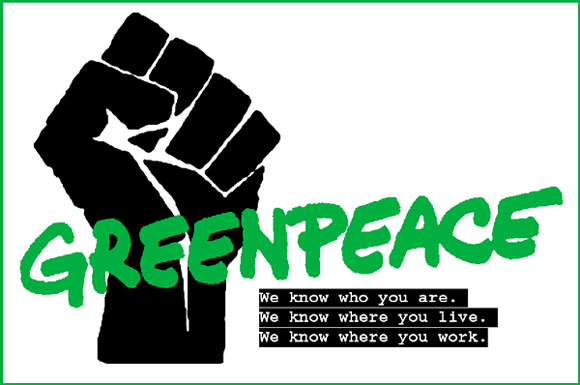
The organization Greenpeace sets another intriguing example. To their credit, they stick with “GE,” mostly, but the credit ends there. Charles Margulis, who serves as Genetic Engineering Specialist at Greenpeace, was interviewed for a documentary and on camera offered this sobering wake-up call to the alleged doom headed our way: “There is no government requirement that GE foods be tested in the U.S. Not a single government agency, not the FDA, USDA, EPA, none of them, require that GE food be tested for human health effects.”
That’s an exact quote, and it sounds pretty scary. But consider a few facts, such as that Mr. Margulis is not Dr. Margulis, has no scientific degree of any kind, not in genetics, chemistry, biology, or botany, and in fact came to become the Greenpeace Genetic Engineering Specialist directly from a stint as the Director of the Westminster (NY) People’s Action Coalition. Quite a pedigree.
Then understand that everything he states in the above quote is false. Not partly true, not selectively true, but purely and completely false.
In truth, genetically engineered crops are the most highly tested foods ever created. They are regulated by, yes, the FDA, the USDA, and the EPA. These crops go through millions of dollars of testing and years of studies before a single plant can be grown as a commercial crop outside a controlled environment. The American Association for the Advancement of Science states that GMO crops (including GE) are “the most extensively tested crops ever added to our food supply” (AAAS 2012). The US Food and Drug Administration has found that all current 148 transgenic crop combinations grown around the world are equivalent to their conventional counterparts. Regulators in Japan have published the same conclusion (Herman and Price 2013).
After a decade of publically funded research, the European Commission concluded that there is no scientific evidence of risk from GMO/GE crops to the environment or for food and livestock feed safety (European Commission 2011).
None of that fazes activist organizations such as Greenpeace, who at the 2002 Environment Summit in Africa were instrumental (along with the organization Friends of the Earth) in convincing representatives from Zambia to turn down millions of tons of GMO food from the US that could have fed their starving population. Even though Zambia and several other African nations were set to encounter their worst famine conditions in a decade, the activists told Zambian leaders that the food was “poisonous.”
Zambia and several other African countries also opted out of accepting seed and growing genetically enhanced crops designed to survive their harsh growing conditions, produce higher yields per acre than the plagued crops they try to grow, and involve far lower usage of chemical controls. Did humans starve to death as a result? Yes.
Nice work, Greenpeace. You should have stuck to saving whales, an act for which you had my complete support.
And please, no e-mails from people pointing out that GMO/GE crops are under moratoriums in parts of Europe. As if that means something. Get enough people to sign a piece of paper and enough $300-an-hour lawyers involved, you can force your city, county or federal government to place a moratorium on tofu. The e-mailers always get the number of countries wrong anyway, since the moratoriums are constantly being lifted, after government leaders listen to the Charles Margulis’s of the world, then listen to the expert scientists, and conclude that fact trumps fiction.
I shake my head at the activists in this country who clamor against the amount of GMO and GE foods in American grocery stores. The aisles of your nearest grocery store brimming with the freshest of foods, your bellies full each and every day, you exist under the mistaken impression that this is all about you. It’s not. This is about helping the people starving worldwide, the safeguarding of the world’s food supply, the lifetimes of hard work put in by the best minds on the planet focusing ten, twenty, fifty years down the road, doing what it will take to ensure a steady food supply to the growing human population.
The single greatest factor in the reduction of worldwide starvation rates as well as in the ever-growing supply of food around the globe is the development of GMO and GE foods over the last sixty years, and there isn’t a university food scientist or accredited food expert in the world who would disagree with that statement. Not that your typical anti-GMO activist would ever speak to one.
If a food manufacturer such as Giants Sunflower Seeds chooses to advertise that their product is non-GMO, fine. It’s a scam, a marketing ploy preying on ignorance, but I’ll buy them anyway. But only because their seeds are the official sunflower seeds of the Minnesota Twins, not due to some misperception that, wow, non-GMO sunflower seeds are somehow safer or superior. They aren’t.
What they are, if you understand science, is doomed, whatever sunflower seed strain is currently in use for Giants seeds, just as all crop strains become, once Mother Nature eventually turns her eye on them, and delivers the pest, or blight, fungus or virus that wipes them off the face of the earth, as has happened over and over for thousands of years. The GMO will be there, and will save the day, designed decades ago for just such a contingency.
A very good thing, as I do like my seeds.
High Spot Award
Best New Gardening Product: Overland Electric Wheelbarrows and Carts
Electricwheelbarrows.com
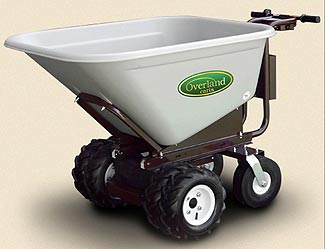 A kid in a candy store, that was me this fall on landscaping jobs where all I wanted to do was move material around using my brand-spankin’ new electric cart. I had seen one in use in 2013 – a buddy of mine who runs a landscaping business had picked one up at a trade show, and let me take it for a spin.
A kid in a candy store, that was me this fall on landscaping jobs where all I wanted to do was move material around using my brand-spankin’ new electric cart. I had seen one in use in 2013 – a buddy of mine who runs a landscaping business had picked one up at a trade show, and let me take it for a spin.
The sly devil – it was more than a bit like Tom Sawyer reluctantly showing Ben Rogers and the other boys how amazingly fun it was to whitewash a fence. While my buddy sat in his pickup, smoking heaters and catching up on phone calls, I probably mulched half his completed planting job. His electric cart made it so effortless and fun.
For aging gardeners, gardeners with large and/or hilly properties, female gardeners, or heck, the strongest male gardener in America who is faced with moving a large pile of soil, sand, gravel, mulch or patio stone from point A to point B, these are leg, arm, back and time savers.
Made in America, there are a variety of models to choose from, from four-wheel wheelbarrows (with larger capacity than standard wheelbarrows) to nine-cubic-feet carts (although for moving mulch, we typically can mound up close to half a yard). Some feature electric dumping. They are ruggedly built, with heavy-traction pneumatic tires in front and solid rubber tires in back.
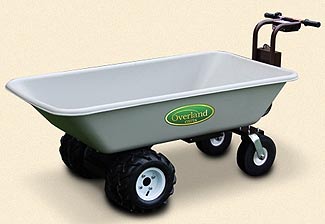 They’re just so cool to use. All the controls are at the bar steering handle, forward, reverse, on and off. They feature an automatic brake system – take your hand off the handle, the thing stops and locks, even on hills. Empty, they will scoot along at a brisk walking pace; fully loaded (weight capacity is 750 pounds) they move silently at the same speed a heavily loaded wheelbarrow moves at when you’re the one supplying the horsepower.
They’re just so cool to use. All the controls are at the bar steering handle, forward, reverse, on and off. They feature an automatic brake system – take your hand off the handle, the thing stops and locks, even on hills. Empty, they will scoot along at a brisk walking pace; fully loaded (weight capacity is 750 pounds) they move silently at the same speed a heavily loaded wheelbarrow moves at when you’re the one supplying the horsepower.
The rechargeable battery system allows on/off use for up to eleven hours. When the charge light shows a low level, just plug it in to any conventional outlet. The 12-volt, 24-amp AGM type battery will last one year in moderate to heavy use, and a replacement battery will be easy to find locally for less than $100. (You can buy replacement batteries from the manufacturer also, but they’ll tell you to buy it locally, to save you the shipping cost.)
FULL DISCLOSURE: After writing about their products in a column that appeared in Northern Gardener magazine this summer, the sales manager contacted me and asked if I would like to test one, free of charge, for two months, after which I could buy it, or ship it back at their cost.
I bought it. Now I have yet another tool in my management toolbox: Any crewmember who is late for work at the job site, that’s two days you don’t get to use the electric cart.
Here’s the website for purchasing and more information: www.electricwheelbarrows.com.
Black Spot Award
Worst Garden Sculpture

Objections? Discussion? Any sore losers? I thought not.
High Spot Award
Best Corporate Lead: Bank of America Cuts Water Use Fifty Percent
 According to a story in Environmental Leader, Bank of America has transitioned to xeriscaping in six of its corporate banking centers in California. Simply by removing turf grass and replacing campuses with native and adapted plants, applying mulch to their grounds, and converting irrigation systems to drip lines and micro-emitters, they’ve reduced landscaping water usage by three million gallons.
According to a story in Environmental Leader, Bank of America has transitioned to xeriscaping in six of its corporate banking centers in California. Simply by removing turf grass and replacing campuses with native and adapted plants, applying mulch to their grounds, and converting irrigation systems to drip lines and micro-emitters, they’ve reduced landscaping water usage by three million gallons.
That’s a fifty-percent reduction. Bank of America already has instituted water management programs at over 100 other bank locations that have complete or partial xeriscaping.
Well done, Mr. Giant Corporation. Now, if we could just talk about those silly maintenance, overdraft, and Foreign Fund fees of which I occasionally fall prey…
Black Spot Award
Worst Gardening Product: Rubber Mulch
 This, the final and most prestigious award handed out each year, is typically bestowed upon a garden product that is either ugly, harmful, or purports to be an improvement on a product that doesn’t need improving. Rarely do the judges encounter a product that is all three.
This, the final and most prestigious award handed out each year, is typically bestowed upon a garden product that is either ugly, harmful, or purports to be an improvement on a product that doesn’t need improving. Rarely do the judges encounter a product that is all three.
Well, step aside, previous winners, because rubber mulch is well on its way to being named the worst gardening product of all time. What started out as an eco-friendly love fest has turned into an eco-hazard minefield. How blind were we? The stuff is currently sold, and in use, across the state of California – and that’s saying something.
The product is principally made from ground-up tires. We have a problem with old tires in the U.S., they’re made of rubber, contain dozens of toxic and carcinogenic chemicals that are released as the rubber degrades, so you don’t really want them in landfills. After all, in most states, used tires are classified as “hazardous waste,” and require a special permit to dispose of. But what if they were recycled? Recycling is always good, isn’t it?
So some genius, at some point, was the first person to decide that used tires could be recycled into…playground mulch! It never needs replenishing, doesn’t wash away in rain, and kids bounce off it! Schools districts will save a fortune!
Next came rubber mulch for the garden, in a variety of dyed colors. In the past ten years, rubber mulch has been sold to landscapers and homeowners by the thousands of tons, in bags and in bulk.

Oopsie.
When looked into by the group Environmental & Human Health, Inc., a nine-member, non-profit organization composed of physicians, public health professionals and policy experts (that refuses corporate funding), things didn’t look so rosy. They pulled together the following information from private and university research on rubber mulch:
Mulch from ground-up tires contains:
- Benzoathiazole – a skin and eye irritant, harmful if swallowed.
- Butylated hydroxyanisole – a recognized carcinogen.
- Benzene, a carcinogen, developmental toxicant and reproductive toxicant.
- PAHs – a suspected developmental toxicant, liver toxicant and respiratory toxicant.
- Manganese – a gastrointestinal and liver toxicant.
- Carbon Black – a recognized carcinogen.
- Zinc – high levels of zinc are used in tires.
And I’ve skipped some. But hold on, what if these chemicals aren’t released into the environment by the mulch? The tires aren’t pulverized, after all, merely shredded. You know me, I wait to see what university scientists can prove or disprove.
Dr. Linda Chalker-Scott, PhD., an Associate Professor and Urban Horticulturalist at Washington State University, has studied the rubber mulch issue and has this to say: “It is abundantly clear from scientific literature that rubber should not be used as a landscape amendment or mulch. There is no question that toxic substances leach from rubber as it degrades, contaminating the soil, landscape plants, and aquatic systems. While recycling waste tires is an important issue to address, it is not a solution to simply move the problem to our landscape and surface waters.”
Further, a study by the North Carolina Department of Agriculture found that ground rubber mulch contains 1.55 percent zinc. As the rubber degrades (a process that begins immediately, from a chemical standpoint) zinc bound in rubber in acidic soils increases zinc levels to above the norm, causing a decline in plant growth attributable to zinc toxicity.
Possible – but not yet proven, I stick to facts – fear among soil and horticulture scientists is of ground water contamination, as well as chemical residues in fruits and vegetables grown in areas mulched by degrading rubber mulch.
Here’s a link to Dr. Chalker-Scotts’ paper on rubber mulch:
puyallup.wsu.edu/~linda%20chalker-scott/horticultural%20myths_files/Myths/Rubber%20mulch.pdf
Well, sorry to end the 2014 Renegade Gardener High Spot/Black Spot Awards on such a bummer, but Worst Gardening Product is always the final award, so the program inevitably ends this way.
I have bigger fish to fry, as I have just been informed by the Cuban police that I and my crew are to be escorted immediately to the Havana airport. Even my elementary skills in Spanish are enough to translate, “Una vez que te dan en el avión, que nunca queremos ver sus feas caras de nuevo!”
 Don Engebretson
Don Engebretson
The Renegade Gardener
Don Engebretson
The Renegade Gardener
- The 2018 Renegade Gardener High Spot/Black Spot Awards January 5, 2019
- The 2017 Renegade Gardener High Spot/Black Spot Awards January 1, 2018
- The 2016 Renegade Gardener High Spot/Black Spot Awards January 1, 2017
- The 2015 Renegade Gardener High Spot/Black Spot Awards January 1, 2016
- The 2014 Renegade Gardener High Spot/Black Spot Awards January 7, 2015
- The 2013 Renegade Gardener High Spot/Black Spot Awards January 1, 2014
- The 2012 Renegade Gardener High Spot/Black Spot Awards January 4, 2013
- The 2011 Renegade Gardener High Spot/Black Spot Awards January 1, 2012
- The 2010 Renegade Gardener High Spot/Black Spot Awards January 1, 2011
- The 2009 Renegade Gardener High Spot/Black Spot Awards January 1, 2010
- The 2008 Renegade Gardener High Spot/Black Spot Awards January 1, 2009
- The 2007 Renegade Gardener High Spot/Black Spot Awards January 3, 2008
- The 2006 Renegade Gardener High Spot/Black Spot Awards December 20, 2006
- The 2005 Renegade Gardener High Spot/Black Spot Awards December 9, 2005
- The 2004 Renegade Gardener High Spot/Black Spot Awards January 1, 2005
- The 2003 Renegade Gardener High Spot/Black Spot Awards November 19, 2003
- The 2002 Renegade Gardener High Spot/Black Spot Awards October 31, 2002
- The 2001 Renegade Gardener High Spot/Black Spot Awards October 16, 2001
- The 2000 Renegade Gardener High Spot/Black Spot Awards October 20, 2000